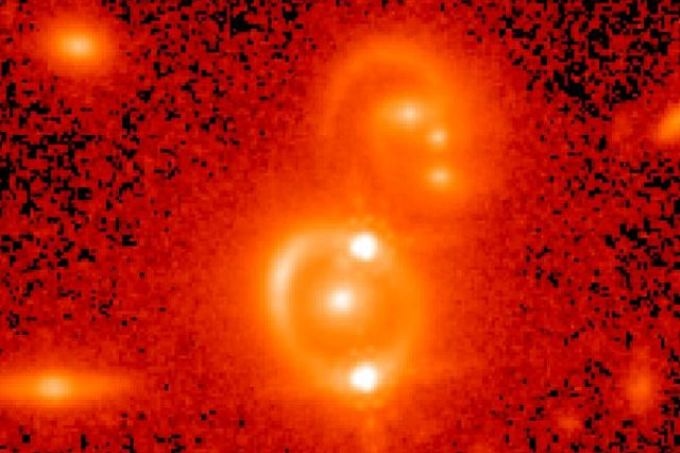Jan 23 2019
For nearly a century, astronomers have always been puzzled by the way the universe is rapidly expanding. In this regard, numerous studies continue to emerge with different answers, causing some scientists to wonder whether they have overlooked an important mechanism in the machinery driving the cosmos.
 A Hubble Space Telescope picture of a doubly imaged quasar. (Image credit: NASA Hubble Space Telescope, Tommaso Treu/UCLA, and Birrer et al)
A Hubble Space Telescope picture of a doubly imaged quasar. (Image credit: NASA Hubble Space Telescope, Tommaso Treu/UCLA, and Birrer et al)
Now, a research team, headed by UCLA astronomers, has developed a novel way to determine how rapidly the cosmos is growing, representing a step towards resolving the dispute. The researchers’ study has been reported in Monthly Notices of the Royal Astronomical Society.
At the core of the debate is the Hubble constant, a number that relates distances to the galaxies’ redshifts—the amount of light that is extended as it moves to Earth via the expanding universe. Now, estimates for the Hubble constant range from approximately 67 to 73 km per second per megaparsec, implying that a couple of points in space 1 megaparsec apart—the equivalent of 3.26 million light-years—are running away from one another at a speed ranging from 67 to 73 km per second.
“The Hubble constant anchors the physical scale of the universe,” stated Simon Birrer, the study’s lead author and a UCLA postdoctoral scholar. Without an exact value for the Hubble constant, astronomers cannot precisely establish the expansion history of the cosmos, the age of the universe, or the sizes of distant galaxies.
The majority of techniques developed for deriving the Hubble constant include two ingredients—a distance to a certain source of light and the redshift of that light source. Searching for a light source that had not been utilized in the calculations of other researchers, Birrer and coworkers turned to quasars, which are fountains of radiation driven by gargantuan black holes. For their study, the investigators selected one particular subset of quasars, in which the light has been bent by the gravity of a meddling galaxy, which creates a pair of side-by-side quasar images on the sky.
Light from both the images takes varied routes to Earth. When the brightness of the quasar varies, the two images, instead of flickering simultaneously, do so one after another. The time delay between those two flickers, together with data about the gravitational field of the intervening galaxy, can be used for tracing the journey of the light and infer the distances from Earth to the foreground galaxy and also to the quasar. This knowledge about the redshifts of the galaxy and quasar allowed the researchers to estimate how rapidly the universe is growing.
As part of the international H0liCOW partnership, the UCLA research team had earlier used the technique for examining quadruply imaged quasars, wherein a quasar’s four images emerge around a foreground galaxy. However, quadruple images are not almost as common—double-image quasars are believed to be roughly five times as abundant as the quadruple counterparts.
In order to demonstrate this method, the UCLA-led research group examined a doubly imaged quasar called SDSS J1206+4332; they depended on information from the Hubble Space Telescope, the W.M. Keck, and Gemini observatories, and also from the Cosmological Monitoring of Gravitational Lenses (COSMOGRAIL) network—a program handled by Switzerland’s Ecole Polytechnique Federale de Lausanne and dedicated in establishing the Hubble constant.
According to Tommaso Treu, the study’s senior author and a UCLA professor of physics and astronomy, the scientists captured the quasar images every day for a number of years to accurately determine the delay in time between the images. Then, in order obtain an optimum estimation of the Hubble constant, they integrated the data collected on that quasar with the data that had earlier been collected by their H0liCOW association on three quadruply imaged quasars.
“The beauty of this measurement is that it’s highly complementary to and independent of others,” stated Treu.
Eventually, the UCLA-led research team developed an estimate for the Hubble constant of roughly 72.5 km per second per megaparsec, a figure corresponding with what other researchers had established in studies that applied distances to supernovas—exploding stars in distant galaxies—as the crucial measurement. Yet, both estimates are approximately 8% higher than one that depends on a feeble glow from all over the sky referred to as the cosmic microwave background, a remnant from 380000 years after the Big Bang, when light freely moved via space for the first time.
“If there is an actual difference between those values, it means the universe is a little more complicated,” said Treu.
However, it could also mean that a single measurement—or all three measurements—are wrong, said Treu.
Currently, the researchers are exploring more quasars to enhance the accuracy of their Hubble constant measurement. One of the most significant lessons of the latest study is that doubly imaged quasars provide researchers with many more valuable light sources for their Hubble constant calculations, added Treu. For the time being, the UCLA-led team is concentrating its studies on 40 quadruply imaged quasars, due to their ability to offer even more valuable data than doubly imaged equivalents.
The paper was contributed by 16 other scientists from 13 institutions in 7 countries. The research was partly supported by grants from NASA, the National Science Foundation, and the Packard Foundation.